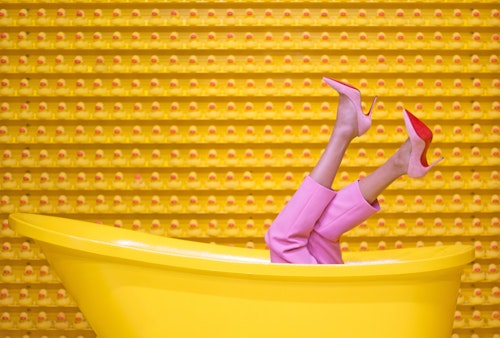7 reasons why women should stop wearing high heels
Written By
Joy EmehHuman Anatomist | Health Editor

Is wearing high heels healthy?
It is easy to slip on a sophisticated pair of stilettos when you are going out. Walking out your front door, you feel like a goddess ready to charm eyes and turn heads.
But, how does it feel after a long day on high heels? You come back home to throbbing pain on the balls of your feet, sometimes radiating through your legs. Right?
Imagine when you wear heels every day for a prolonged period. It means heels can cause damage to your feet and leg muscles.
There are different reasons why women wear heels- the top reasons are to look taller, show off the shape of their lower limbs and feel the boost of confidence that comes with the clicking of heels on tiles. But, do women really know what happens when they wear heels for long?
What happens when you put on heels?
Photo by Rocketmann on Pexels
Stilettos may turn heads, but they can change the shape of your legs over a period of time. The feet are the base of the body, and their position can affect the entire body skeleton.
Wearing high heels shifts the body’s weight to the balls of the feet, pushes the hips and the knees forward and hyperextends the back backwards.
The inclined shape of high heels causes the contraction of the calf muscles. With time, it will cause the shortening of the muscle fibres and the thickening of the Achilles tendon. This causes pain even when walking in flats or sneakers.
The side effects of wearing high heels
Wearing high heels come with high prices, including leg pain and body discomfort. Below are the effects of high heels on the body and why you should stop wearing them.
1. Arthritis and osteoarthritis
Wearing high heels often can cause the leg and feet joints to become arthritic. This is because wearing high heels can cause the cartilages of the joints to wear down. Arthritis is an inflammation of the joint which causes joint pain, swelling, stiffness and tenderness.
High heels also increase the risk of developing osteoarthritis.4 An osteoarthritis is a form of arthritis that occurs when the protective cartilage that cushions the joints wear down. It is also called “wear and tear” arthritis.
2. Posture and body anatomy
High heels thicken and tighten the tendons. They shorten the calf muscles and also put a strain on the back and knees. These cause changes in the body’s anatomy and how the rest of the body moves.
Heels push the bodyweight forward and cause the lower back to arch more than usual. A change in posture can put stress on the intervertebral discs (the cushion-like discs in between the vertebrae). This, in turn, leads to back pain and muscle spasms.
3. Ankle injuries and stress fractures
Photo by Vidal Balielo on Pexels
Wearing high-heeled shoes increase the risk of ankle injuries and fractures. You could potentially hurt yourself!
Accidentally stepping on a stone can cause your feet to forcefully turn inwards, causing a strain or breaking of the ligaments in the outer (lateral) side of the ankle. This occurrence is called a lateral ankle sprain.
Ankle sprains are not life-threatening, but they can cause excruciating pain. Their healing also takes time.
4. Toenail damage
Wearing high heels often can cause trauma to the toenails. In fact, it is one of the leading causes of ingrown toenails. An ingrown toenail occurs when the nail grows into the skin of the toes instead of growing over it.
Most stilettos compress the toes together, causing the toenails (especially the big toenails) to grow into the skin. Wearing tight shoes causes the nails to dig into the skin of the toe.1 An ingrown toenail can easily get infected. It can be red, painful, swollen and may drain pus.
5. Hammer toes and bunions
Wearing high heel shoes can increase the risk of having hammer toes. Hammer toe is a toe deformity that causes the toe to curl or bend downwards instead of pointing forward. It is typically caused by pressure from footwear.
In people who already have hammer toes, wearing high heels can increase the chances of developing corns and calluses. Corns and calluses are hardened, thickened layers of skin that form due to the skin’s response to friction and pressure.
Wearing high heels can also worsen bunions. A bunion is a deformity of the joint at the base of the big toe, which causes the toe to point inwards and the joint to shoot out.
One way to relieve the pressure caused by bunions is by wearing well-fitted shoes with flexible soles that support the foot and toes.3
6. Hip and back pain
Wearing stilettos can also affect the back region, causing back pain. The foot’s plantar fascia connects to the calf muscle (in the back of the leg), which in turn connects to the hamstring muscles (in the thigh). The hamstrings attach to the pelvis and lower back; thus, wearing high heels can cause pain that radiates to the back.2
Back pain worsens when you have spine injuries such as sciatica, spondylolisthesis, and foramina stenosis.
High heels can also trigger fractures and trapped nerves, causing straining of the hip joint.
7. Muscle pain and spasms
This is one of the most common side effects of wearing high heels. In most cases, muscle pain occurs instantly and not overtime. Wearing tight, high-heeled footwear stresses the muscles of the feet and legs. It also shortens the calf muscles causing pain and spasm.
Most women experience painful leg cramps after wearing high heels. You mustn’t ignore your body’s warning signs. If a shoe is too tight and too high for you, discard it and opt for mid- and low-heels instead.